Salvia, also known as sage, is a beloved plant among gardeners for its vibrant flowers, aromatic foliage, and versatility in garden design. With a wide range of species and cultivars, Salvia can fit into almost any garden style or climate. Understanding the different varieties of Salvia and their specific care needs is crucial for gardeners looking to cultivate a thriving and beautiful garden. Our gardening blog is a perfect place to find all the information you need!
Understanding Salvia
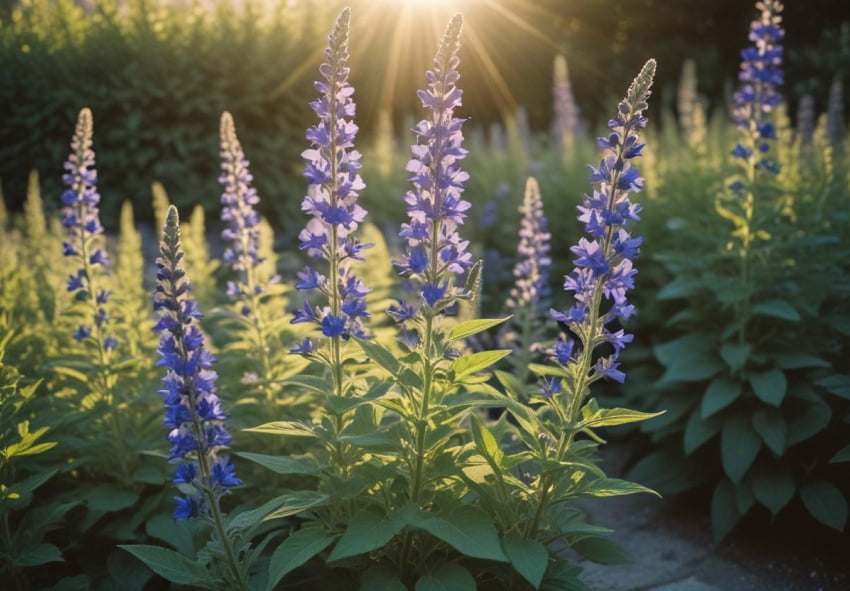
Salvia belongs to the mint family and encompasses a diverse group of plants ranging from annuals to perennials and even biennials. The type of Salvia you choose can dramatically impact your garden’s aesthetic and maintenance requirements.
Types of Salvia
Each type has unique characteristics, such as flowering patterns, foliage texture, and growth habits. Common Salvia varieties include:
| Botanical Name | Flowering Period | Flowering Patterns | Fragrance | Growth Habits |
| Salvia officinalis | Late Spring to Fall | Spikes of small flowers | Strong, earthy, and herbal | Upright, bushy |
| Salvia microphylla | Spring to Fall | Open, airy flower spikes | Strongly aromatic foliage | Bushy, spreading |
| Salvia guaranitica | Summer to Frost | Long, tubular flowers | Lightly scented flowers | Upright, bushy |
| Salvia leucantha | Late Summer to Fall | Velvety, arching spikes | Mildly fragrant foliage | Arching, shrub-like |
| Salvia farinacea | Spring to Fall | Dense flower spikes | Lightly scented flowers | Upright, compact |
Salvia’s Natural Habitat
Native to various regions worldwide, Salvias naturally thrive in environments that range from the Mediterranean’s dry, sunny hillsides to the damp woodlands of North America. To successfully cultivate Salvia in your garden, it’s essential to replicate these natural conditions. This often means ensuring plenty of sunlight, well-draining soil, and adequate space for air circulation.
Planting Salvia
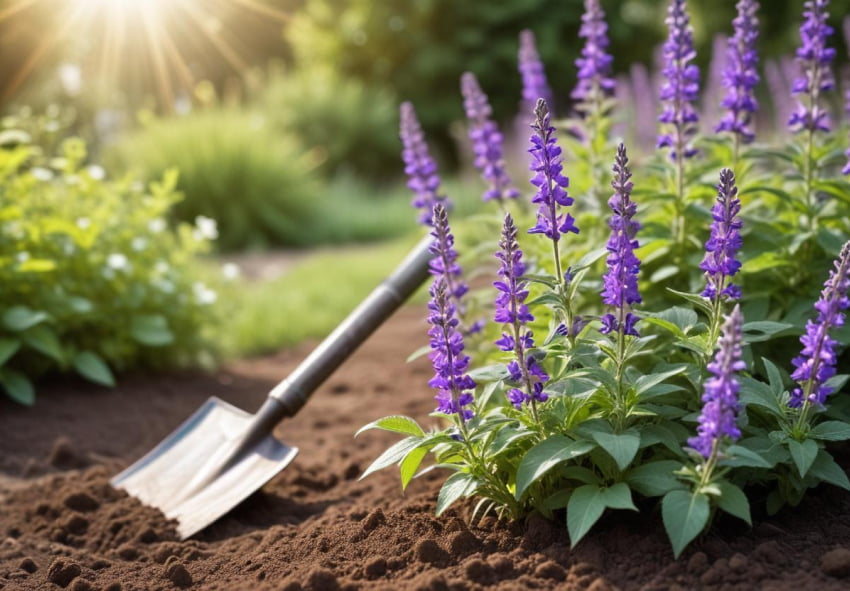
Successfully planting Salvia involves careful consideration of the location, timing, and techniques used. Salvia’s vibrant blooms and ease of care make it a popular choice for gardeners, but proper planting is key to ensuring it thrives in your garden.
Choosing the Right Location
Selecting the right spot in your garden is crucial for Salvia’s growth. These plants thrive in full sun, requiring at least six to eight hours of direct sunlight daily. While Salvia can tolerate various soil types, it prefers well-drained soil with moderate fertility. Good air circulation around the plants is essential to prevent fungal diseases. When planning your garden layout, consider the mature size of your Salvia variety and space them accordingly to avoid overcrowding.
Best Time to Plant Salvia
The optimal planting time for Salvia varies depending on the variety and your local climate. In general, the best time to plant Salvia is in the spring after the last frost when the soil has warmed. This allows the plants to establish their root systems before the heat of summer. In regions with mild winters, fall planting can also be successful. It is important to consult your local hardiness zone map to determine the most appropriate planting time for your specific area.
How to Plant Salvia
To plant Salvia, follow these recommendations:
- Prepare the Soil: Loosen the soil in the planting area to a depth of about 12 inches. Mix in compost or a well-balanced fertilizer to improve soil fertility and drainage.
- Sow Seeds or Plant Transplants: For seeds: Sow them directly into the prepared soil and cover lightly with soil. For transplants: Dig a hole slightly larger than the root ball, place the plant in the hole, and backfill with soil.
- Water Thoroughly: Water the newly planted seeds or transplants thoroughly to settle the soil and eliminate air pockets.
- Mulch Around Plants: Apply a layer of organic mulch around the base of the Salvia plants to conserve moisture, regulate soil temperature, and suppress weeds.
- Ensure Adequate Sunlight: Place Salvia in a location where it will receive at least six to eight hours of direct sunlight daily.
- Monitor Growth: Check the plants regularly for signs of pests or diseases and take corrective actions as needed.
Growing Salvia
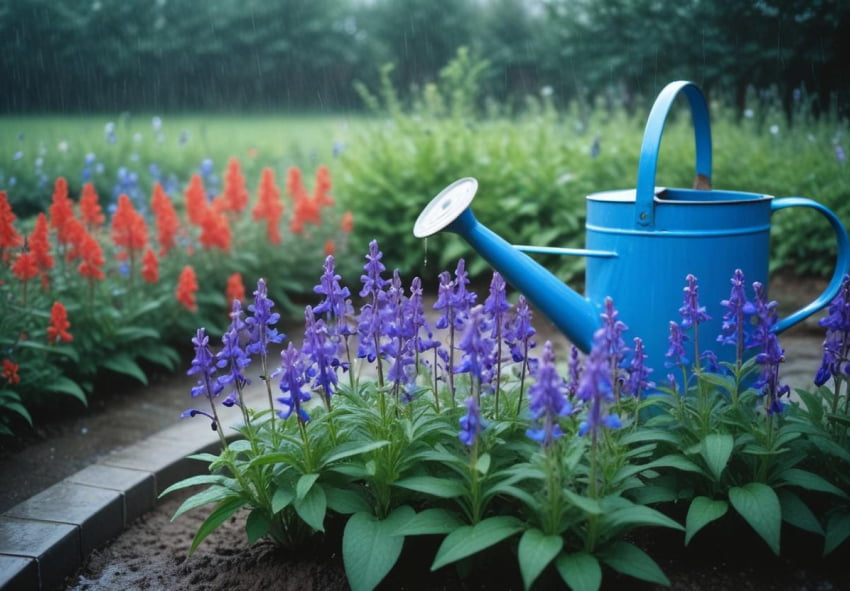
Once planted, Salvia requires ongoing care to maintain its health and beauty. Proper watering, fertilization, and maintenance practices are key to thriving plants.
Watering Requirements
Salvia is relatively drought-tolerant once established, but consistent watering is crucial during the initial growth period. Water the plants deeply once a week, allowing the soil to dry slightly between waterings to prevent root rot. Avoid overwatering, which can lead to fungal diseases, and water at the base of the plant rather than from overhead to keep the foliage dry.
Fertilizing Salvia
To promote healthy growth and abundant blooms, fertilize Salvia with a balanced, slow-release fertilizer in early spring. A second application can be made in mid-summer if the plants show signs of nutrient deficiency. Avoid over-fertilizing, as this can lead to excessive foliage growth at the expense of flowers. The use of organic compost can also improve soil nutrition and support healthy plant development.
Pruning and Maintenance
Regular pruning is essential for maintaining the shape and health of Salvia plants:
- Regular Pruning: Prune Salvia plants regularly to encourage bushier growth and prevent legginess. Cut back stems by about one-third after the first bloom to stimulate a second round of flowering.
- Deadheading Spent Flowers: Remove spent flowers promptly to extend the blooming period and prevent the plant from going to seed. Pinch or cut the flower stems just above the first set of healthy leaves.
- Seasonal Cutback: In late fall or early spring, cut back Salvia plants to about 6 inches above the ground. This encourages vigorous growth and reduces the risk of winter damage or disease.
- Monitor Plant Health: Regularly inspect plants for signs of pests or diseases. Remove any damaged or diseased foliage to prevent the spread of problems.
Mulching and Weed Control
Applying a layer of mulch around Salvia plants helps conserve soil moisture, regulate soil temperature, and suppress weed growth. Organic mulches like straw, bark, or compost are effective and add nutrients to the soil as they decompose. Keep the mulch a few inches away from the plant stems to prevent rot and allow for air circulation.
Salvia in Garden Design
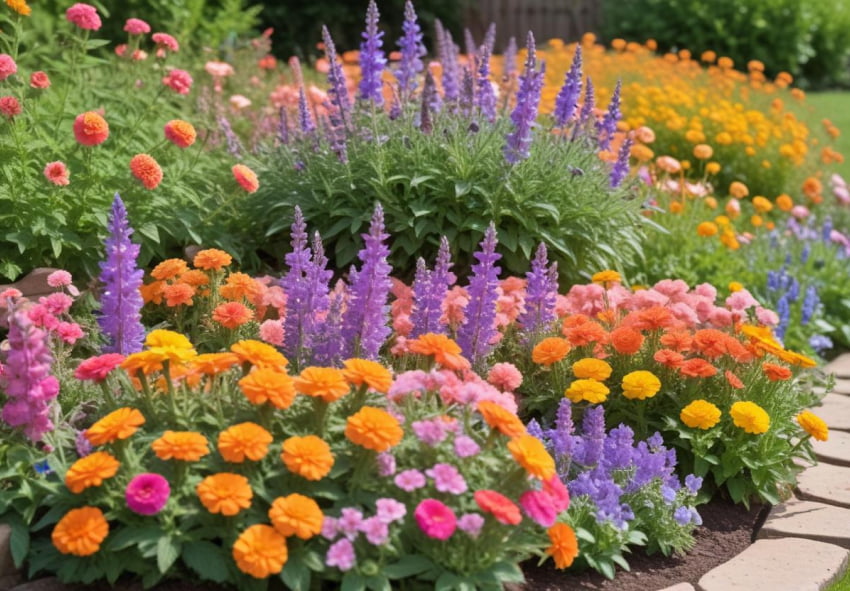
Incorporating Salvia into your garden design can enhance its visual appeal and attract beneficial pollinators. With their striking blooms and varying heights, Salvias can be used in a multitude of garden settings.
Landscaping with Salvia
Salvia’s vibrant flowers and upright growth habit make it an excellent choice for garden beds and borders:
- Creating Borders and Edges: Use Salvia to define garden borders and pathways with vibrant color and texture. Plant in groups for a more striking visual impact along garden edges.
- Mixed Planting Beds: Combine Salvia with a variety of perennials and annuals for a dynamic and diverse garden bed. Pair with plants of different heights and textures to add depth and interest.
- Color Coordination: Select Salvia varieties that complement the color scheme of your garden. Consider the flower color, leaf texture, and bloom time for a harmonious garden design.
Salvia in Containers
Salvia can also be grown in containers, making it a versatile option for patios, balconies, and small gardens. When planting Salvia in pots, select a container that provides enough space for root development and good drainage. Combine Salvia with trailing plants or ornamental grasses for a dynamic and visually appealing arrangement. Ensure that potted Salvia receives adequate sunlight and monitor the soil moisture regularly to prevent drying out.
Pest and Disease Management
Salvia, though generally robust, can fall prey to various pests and diseases. Understanding these potential issues and knowing how to combat them is crucial for maintaining a healthy Salvia garden.
Common Pests Affecting Salvia
Identifying the common pests that affect Salvia is the first step in protecting your plants. Aphids, spider mites, and whiteflies are frequent culprits that feed on the plant’s sap, leading to weakened growth and discolored leaves. Aphids often cluster on the undersides of leaves and on tender new growth. Spider mites leave tiny webs and stippled leaves, while whiteflies can be spotted flying around when the plant is disturbed.
To manage these pests, consider using a combination of natural and chemical methods. Introducing beneficial insects like ladybugs and lacewings can help control aphid populations. For spider mites and whiteflies, spraying the plant with a strong jet of water or applying insecticidal soap or neem oil can be effective. For severe infestations, you may need to resort to chemical pesticides, but always follow the instructions carefully to minimize harm to beneficial insects and the environment.
Disease Prevention
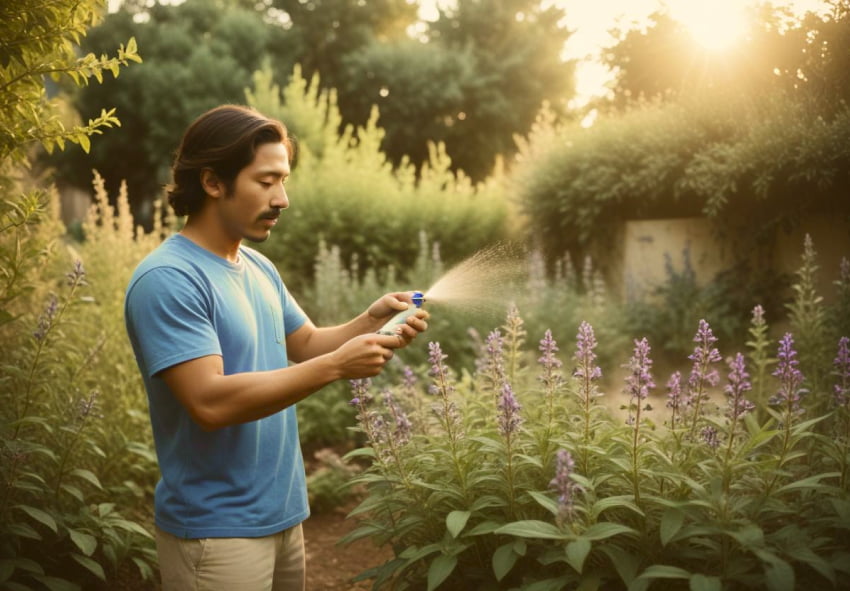
Salvia can also be affected by diseases such as powdery mildew and root rot. Powdery mildew appears as a white, powdery coating on the leaves and stems, particularly in conditions of high humidity and poor air circulation. Root rot, caused by overwatering or poorly drained soil, leads to yellowing leaves and a mushy stem base.
To prevent these diseases, ensure your Salvia has plenty of space for air to circulate around the plants. Water at the base of the plant rather than from overhead to keep the foliage dry, and avoid overwatering by allowing the soil to dry out slightly between waterings. If powdery mildew appears, treat it with a fungicide or a homemade remedy like a baking soda solution. For root rot, improving soil drainage and reducing watering frequency can help prevent further spread.
Propagating Salvia
Propagating Salvia is a rewarding way to expand your garden or share your favorite varieties with friends. There are two main methods of propagation: by seeds and by cuttings.
- Propagation by Seeds
Growing Salvia from seeds requires a bit of patience and the right conditions. Start by filling a seed tray with a well-draining potting mix and sow the Salvia seeds on the surface, lightly covering them with a thin layer of soil. Keep the soil moist and place the tray in a warm, bright spot, but out of direct sunlight. Germination can take anywhere from one to three weeks, depending on the variety. Once the seedlings are large enough to handle, transplant them into individual pots or a prepared garden bed, ensuring they have enough space to grow.
- Propagation by Cuttings
Propagating Salvia using stem cuttings is a faster method and often results in a plant that is identical to the parent. Choose a healthy Salvia plant and take a cutting of about four to six inches long from a non-flowering stem. Remove the leaves from the lower half of the cutting and dip the cut end in rooting hormone. Plant the cutting in a pot filled with a mix of peat and perlite or a similar well-draining medium. Keep the soil moist and place the pot in a bright, warm location. Roots should develop within a few weeks, and the cutting can then be transplanted into the garden or a larger pot.
Benefits of Growing Salvia
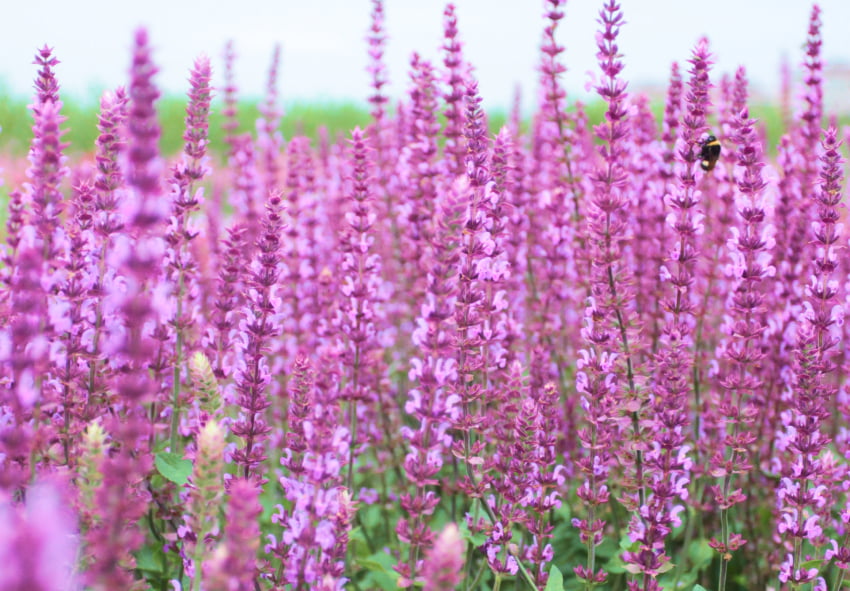
Salvia is not only a beautiful addition to your garden but also offers several ecological and practical benefits. That’s why these magnificent flowers are perfect for your outdoor garden.
Attracting Pollinators
One of the most significant benefits of Salvia is its ability to attract pollinators such as bees, butterflies, and hummingbirds. The tubular flowers of Salvia are perfectly shaped for these pollinators to access the nectar, making your garden a lively and dynamic environment. Planting Salvia can help support local ecosystems and promote biodiversity by providing essential resources for these beneficial creatures.
Drought Tolerance
Salvia’s natural drought tolerance makes it an excellent choice for xeriscaping and water-wise gardens. Once established, Salvia requires minimal watering, making it an ideal plant for regions with limited water resources or for gardeners looking to reduce their water usage. By incorporating Salvia into your garden design, you can create a sustainable and low-maintenance landscape that still bursts with color and life.
Conclusion
Understanding the nuances of planting, growing, and caring for Salvia can help gardeners create beautiful and resilient gardens. With its diverse varieties and low-maintenance nature, Salvia is a rewarding plant to include in any landscape. Explore the many different types of Salvia and discover the joy of growing these versatile plants in your garden.
Frequently Asked Questions (FAQs) about Salvia
1. How do I choose the best location to plant Salvia?
Choose a location that receives full sun to partial shade and has well-draining soil. Salvia thrives in sunny spots but can tolerate some shade. Ensure the soil is fertile and enriched with organic matter for optimal growth.
2. Can I order dutch Salvia from your online store?
Yes, we offer a wide selection of Salvia, including some varieties originating from Holland, renowned for their quality and beauty. Our online store Dutch-bulbs.com features a diverse range of Salvia. Explore our collection to find the perfect Salvia varieties for your garden or landscaping projects.
3. How can I propagate Salvia?
Salvia can be propagated through seeds, stem cuttings, or division. Propagating by stem cuttings is often the easiest method and ensures the new plants are identical to the parent. Take 3-4 inch cuttings from healthy plants and root them in a moist, well-draining medium.
4. What pests and diseases commonly affect Salvia?
Common pests include aphids, spider mites, and whiteflies, while diseases such as powdery mildew and root rot can affect Salvia. Regular inspection and proper cultural practices, such as adequate spacing and watering, can help prevent these issues.
5. How do I maintain Salvia plants for continuous blooming?
Regular pruning and deadheading are key to promoting continuous blooms in Salvia plants. Remove spent flowers and trim back the plant to encourage new growth and flowering. Fertilize with a balanced fertilizer during the growing season to support healthy development.
Published: 13.08.2024
